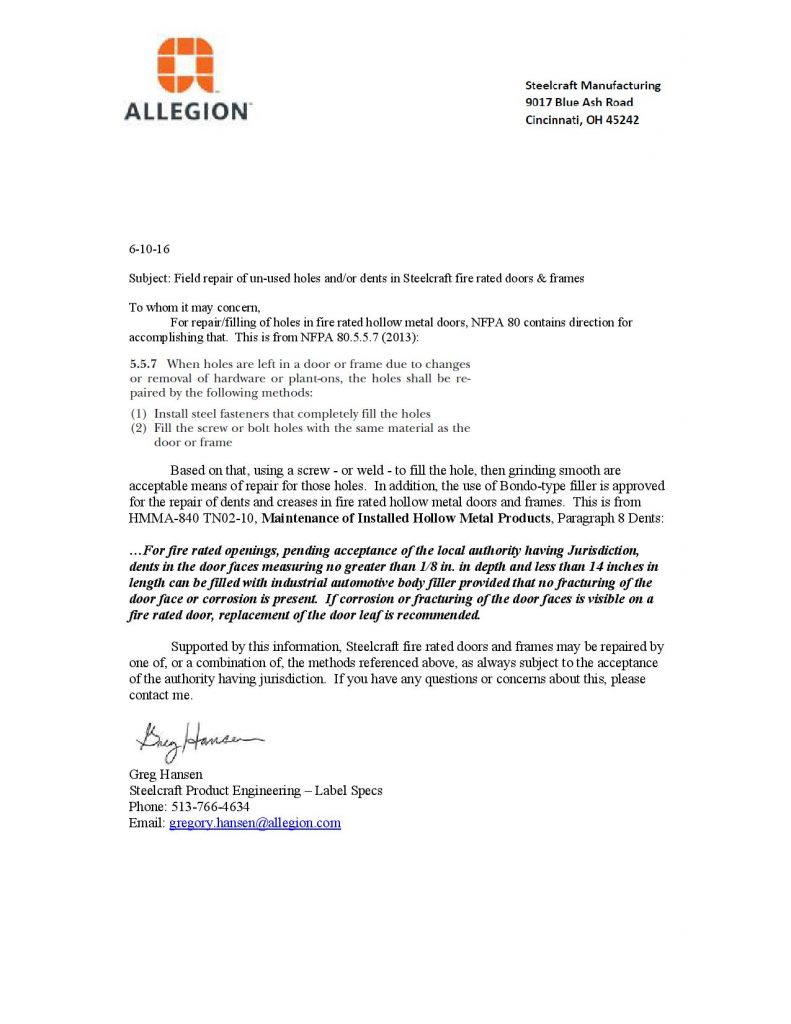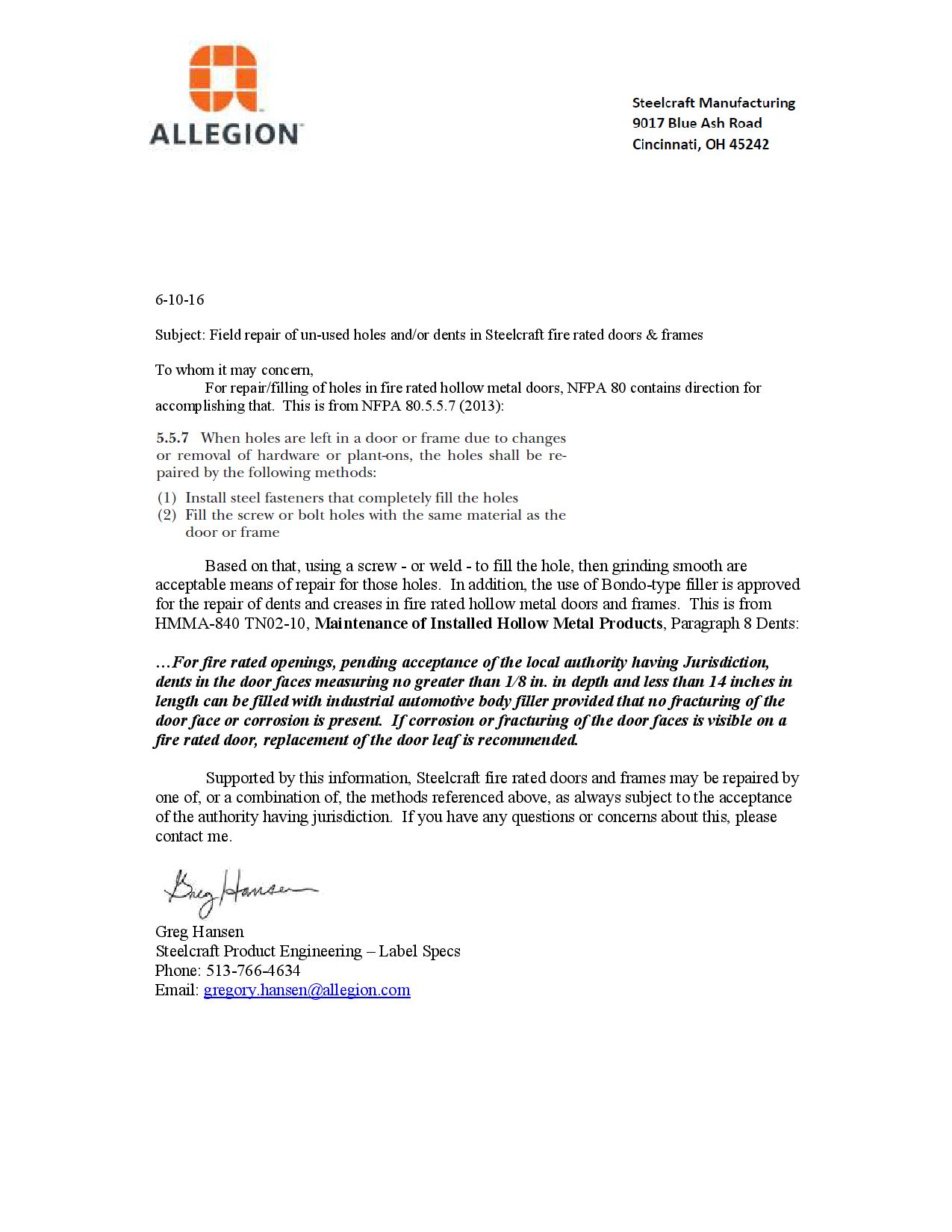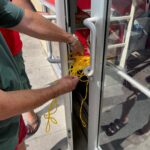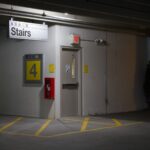 Tuck this away for future reference…
Tuck this away for future reference…
With regard to filling holes in fire door assemblies, NFPA 80 (2013) states:
5.5.7 When holes are left in a door or frame due to changes or removal of hardware or plant-ons, the holes shall be repaired by the following methods:
(1) Install steel fasteners that completely fill the holes
(2) Fill the screw or bolt holes with the same material as the door or frame
A very common repair includes installing steel fasteners in unused holes, grinding off the fastener heads, and concealing the repair with Bondo, but this is not specifically mentioned in NFPA 80. Luckily, Greg Hansen of Steelcraft has fielded this question before, and prepared a letter stating that this method is acceptable for Steelcraft fire-rated doors and frames.
The letter, which can be downloaded here, confirms that a screw or weld can be used to fill the hole, and then ground smooth. Bondo-type automotive body filler is allowed for the repair of dents and creases (not holes) in fire-rated hollow metal doors and frames. These repairs are limited to dents that are no greater than 1/8-inch deep and 14 inches long. As always, the final decision is left up to the code official, but when a manufacturer authorizes a repair method, especially in writing, the code officially typically approves the modification.
If you have any questions or insight on this issue, feel free to leave a comment below.
You need to login or register to bookmark/favorite this content.






Lori,
My question if a metal door had a keypad removed and a entrance lever put back in it’s place and it left a 1 in. hole how big of a hole can be repaired with a though bolt? I thought I read so were or maybe I heard it from somebody that the hole couldn’t be over 3/4 in. do you have any information on this that I could reference or that would show any details in the NFPA IBC etc. all I have access to is the NFPA 80 and NFPA 101 so does this mean the hole can not be no bigger than 1 in. and if it is bigger than one 1 in. it basically could not be repaired in the field.
5.5.7 When fastener holes are left in a door or frame due to
changes or removal of hardware or plant-ons, the holes shall be
repaired by the following methods:
(1) Install steel fasteners that completely fill the holes.
(2) Fill the screw or bolt holes with the same material as the
door or frame.
(3) Fill holes with material listed for this use and installed in
accordance with the manufacturer’s procedures.
5.5.8 Holes, other than those as described by 5.5.7, shall be
treated as a field modification in accordance with 5.1.4.
4.1.3.2* The following job site preparations shall be permitted:
(1) Holes for surface-applied hardware, function holes for mortise locks, and holes for labeled viewers
(2) A maximum 3∕4 in. (19 mm) wood and composite door undercutting
(3) Installation of protection plates (see 6.4.5)
4.1.3.2.1 Surface-applied hardware shall be applied to the door or frame without removing material other than drilling round holes to accommodate cylinders, spindles, similar operational elements, electrified hardware, and through-bolts in doors.
4.1.3.2.2 The holes described in 4.1.3.2.1 shall not exceed a diameter of 1 in. (25.4 mm), with the exception of holes for cylinders, unless otherwise permitted by 4.1.3.2.3.
4.1.3.2.3 Holes exceeding a diameter of 1 in. (25.4 mm) shall be permitted for surface-applied hardware installed in accordance with the door manufacturer’s listing and the hardware manufacturer’s listing.
Hi Terry –
Past editions of NFPA 80 were not clear on this, but the 2016 edition clarifies that the holes that are being addressed are fastener holes – most fastener holes are much less than 1-inch diameter. Holes that are not specifically addressed by NFPA 80 (for example, holes that are not fastener holes), are treated as a field modification. This means that the method of filling the hole may be approved by the listing laboratory, which would be contacted through the manufacturer. There are some products that have been tested for this purpose – like the fire door caulk and thru-bolts that are available here: https://www.firedoorsolutions.com/products/. It’s important to note the limitations of products used to fill holes in fire doors – in this case the caulk is listed for use on wood doors up to 90 minutes with a hole size of 3/4-inch, maximum, and the thru-bolts are listed for holes up to 1/2-inch diameter in hollow metal doors.
– Lori
Lori,
Hope you had a Merry Christmas and Happy New Year
Thank you for the information concerning the holes in fire doors.
Am I permitted to fix a 6×6 hole in a fire rated door. The hole was made in a condo entry door to gain access to the locks of the condo unit during an emergency when the occupant had fallen and could not get to the door.
Thank you for any insights you may have.
Hi Jim –
I don’t think any fire door manufacturer’s listings would allow you to fill/cover a hole that large, but to find out for sure, I would recommend calling the door manufacturer.
– Lori
Hello Lori
I would like to know if there are any products that will fit over a fire rated masonry door frame which the frame has been severely twisted and bent so I would not have to remove existing frame but still retain fire rating
Thank you
Tony
Hi Tony – I don’t know of a good retrofit solution for that, and it may not be allowed by the frame manufacturer’s listings.
– Lori
Hi Lori,
This letter is just what we needed!
We had a few penetrations in frames so we had them welded and sanded in the field.
However our customer is not accepting the letter because they are saying it does not have an engineering stamp on it.
Is this something we could get Steelcraft to stamp and I can send it back over?
I have a slightly different question: what about replacement of the laminate that covers, for instance 20 minutes doors? I have pictures but not sure how to send them.
Hi Kelley –
I doubt that would be allowed by the manufacturer’s listings, but to find out for sure you would have to contact the door manufacturer and ask. That repair is not something that is addressed by the codes and standards.
– Lori
I have a question if i have a fire door with about a 1 inch hole in the frame what would be the best reccomendation to use to fill this hole?
I have looked up and saw they sell frame plugs but was wondering if there was another option.
Thank you,
Hi Kyle –
To get a definitive answer you should ask the manufacturer of the frame – let me know if it’s Steelcraft or Republic and I can find out. The manufacturer’s listings may specify how to fill a hole of that size. NFPA 80 addresses filling fastener holes with steel screws or with the same material as the door/frame, but 1-inch-diameter is kind of a large hole.
– Lori
Can I use quik steel epoxy to fill holes in fire doors
Hi Cookie –
Probably not – filler materials must be specifically listed for filling holes in fire doors. I would recommend checking with the manufacturer of the material and with the manufacturer of the fire door to see what their listings will allow.
– Lori
Can a metal astragel be used on single fire rated door on the pull side
Hi Cookie –
Astragals are typically used on pairs of doors (not on single doors), but the door manufacturer can confirm whether the astragal is allowed by their fire door listings.
– Lori
Cracked formica on a fire rated door? Is that a violation?
Hi Lloyd –
Probably…I would ask the door manufacturer.
– Lori